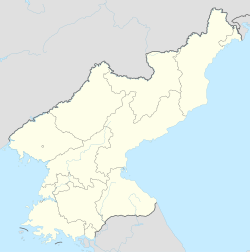Kusong
Kusong
구성시 | |
|---|---|
| Korean transcription(s) | |
| •Chosŏn'gŭl | 구성시 |
| •Hancha | QuyThànhThị |
| •McCune-Reischauer | Kusŏng si |
| •Revised Romanization | Guseong-si |
 Map of North Pyongan showing the location of Kusong | |
 | |
| Coordinates:39°58′N125°10′E/ 39.967°N 125.167°E | |
| Country | North Korea |
| Province | North Pyongan Province |
| Administrative divisions | 24tong,18ri |
| Area | |
| • Total | 666.8 km2(257.5 sq mi) |
| Population (2008) | |
| • Total | 196,515 |
| • Dialect | P'yŏngan |
| Time zone | UTC+9(Pyongyang Time) |
Kusŏng(Korean:구성;Korean pronunciation:[ku.sʌŋ]) is a city in centralNorth Pyonganprovince,North Korea.
It bordersTaegwanto the north,Taechonto the east,KwaksanandChongjuto the south, andChonmato the west. The highest point isChongryongsan(청룡산, 920 m).
Educational institutions located in Kusong includeKusong Mechanical Collegeand Kusong Industrial College. Historical relics include theKoryo dynasty-eraKuju Castle.
Panghyon-dong,anexclaveofPyongyang,was formerly part of Kusong.
Industry
[edit]Kusong is also home to much of North Korea's military industry, with both munitions factories and uranium mines in the area.[1]The No.112, also known as the January 12th Factory was the site of the first successfulHwasong-12launch, with a memorial dedicated to the successful launch nearby.[2]
ThePanghyon airfieldis also located by Kusong,[3]which is a site of missile test launches, including the first successful ICBM test launch by the DPRK.[3]
Kusong is home to the Machine Plant managed by Ho Chol Yong, a large factory that produces tracked vehicles and tanks. This factory saw multiple extensions to it in 2016 and 2020. The factories' expansion is reflected on the increasing use of trackedtransporter erector launchers.[4]
Climate
[edit]The year-round average temperature is 8.2 °C, with a January average of -9.6 °C and an August average of 23.3 °C. 1300 millimeters of rain fall in a typical year. 22% of the county's area is cultivated; 64% is forested.
| Climate data for Kusong (1991–2020) | |||||||||||||
|---|---|---|---|---|---|---|---|---|---|---|---|---|---|
| Month | Jan | Feb | Mar | Apr | May | Jun | Jul | Aug | Sep | Oct | Nov | Dec | Year |
| Mean daily maximum °C (°F) | −0.7 (30.7) |
2.3 (36.1) |
8.8 (47.8) |
16.9 (62.4) |
23.1 (73.6) |
26.8 (80.2) |
28.4 (83.1) |
29.2 (84.6) |
25.7 (78.3) |
18.5 (65.3) |
8.5 (47.3) |
0.2 (32.4) |
15.6 (60.1) |
| Daily mean °C (°F) | −6.6 (20.1) |
−3.4 (25.9) |
2.7 (36.9) |
10.1 (50.2) |
16.4 (61.5) |
21.1 (70.0) |
24.1 (75.4) |
24.2 (75.6) |
19.1 (66.4) |
11.6 (52.9) |
3.0 (37.4) |
−4.9 (23.2) |
9.8 (49.6) |
| Mean daily minimum °C (°F) | −11.7 (10.9) |
−8.6 (16.5) |
−2.4 (27.7) |
3.8 (38.8) |
10.4 (50.7) |
16.3 (61.3) |
20.5 (68.9) |
20.3 (68.5) |
13.9 (57.0) |
5.9 (42.6) |
−1.6 (29.1) |
−9.4 (15.1) |
4.8 (40.6) |
| Averageprecipitationmm (inches) | 6.1 (0.24) |
17.7 (0.70) |
23.3 (0.92) |
53.5 (2.11) |
87.6 (3.45) |
123.0 (4.84) |
342.4 (13.48) |
312.6 (12.31) |
91.8 (3.61) |
52.6 (2.07) |
55.2 (2.17) |
16.6 (0.65) |
1,182.4 (46.55) |
| Average precipitation days(≥ 0.1 mm) | 2.8 | 3.7 | 4.1 | 5.8 | 8.0 | 9.1 | 12.2 | 10.8 | 6.3 | 6.0 | 6.4 | 5.7 | 80.9 |
| Average snowy days | 3.3 | 3.1 | 2.1 | 0.3 | 0.0 | 0.0 | 0.0 | 0.0 | 0.0 | 0.0 | 1.9 | 4.4 | 15.1 |
| Averagerelative humidity(%) | 63.9 | 62.7 | 63.3 | 64.1 | 69.2 | 76.6 | 84.1 | 82.5 | 75.0 | 70.5 | 70.2 | 67.5 | 70.8 |
| Source:Korea Meteorological Administration[5] | |||||||||||||
Administrative divisions
[edit]The city is divided into 24 neighborhoods (dong) and 18 villages (ri).Panghyŏn-dong
(방현동/PhươngHiệnĐộng), a missile industry area, used to be part of the city but it was later transferred to the administration under Pyongyang city in 2018 and is now not part of the city.[6]
|
|
See also
[edit]Footnotes
[edit]This article includes a list ofgeneral references,butit lacks sufficient correspondinginline citations.(May 2017) |
- ^Pike, John."Kusong - North Korean Special Weapons Facilities".globalsecurity.org.
- ^"Commemorating the 2017 Hwasong-12 IRBM Launch?".Beyond Parallel.2019-06-20.Retrieved2021-03-12.
- ^abChoe, Sang-hun (July 4, 2017)."North Korea Claims Success in Long-Range Missile Test".The New York Times.USA.Archivedfrom the original on July 4, 2017.RetrievedJuly 4,2017.
- ^"New Construction Activity at the Kusong Tank Plant".armscontrolwonk.Retrieved2021-03-12.
- ^"30 years report of Meteorological Observations in North Korea (1991 ~ 2020)"(PDF)(in Korean). Korea Meteorological Administration. pp. 210, 294, and 344.Archived(PDF)from the original on 29 January 2022.Retrieved23 March2022.
- ^김준호 (2018-03-05)."북, 미사일 산업지역 평양시 행정구역에 편입".Radio Free Asia.
References
[edit]- International Information Research Institute (국제정보연구소) (1999). "구성시".Bắc Triều Tiên tình báo quan sát 2000 [Bukhan jeongbo chong-ram 2000].Seoul: Author. pp. 835–836.
- http://nk.joins /map/view.asp?idx=i061.htm
Further reading
[edit]- Dormels, Rainer. North Korea's Cities: Industrial facilities, internal structures and typification. Jimoondang, 2014.ISBN978-89-6297-167-5
External links
[edit]- InKorean languageonline encyclopedias:
- City profile of KusongArchived2016-03-09 at theWayback Machine


